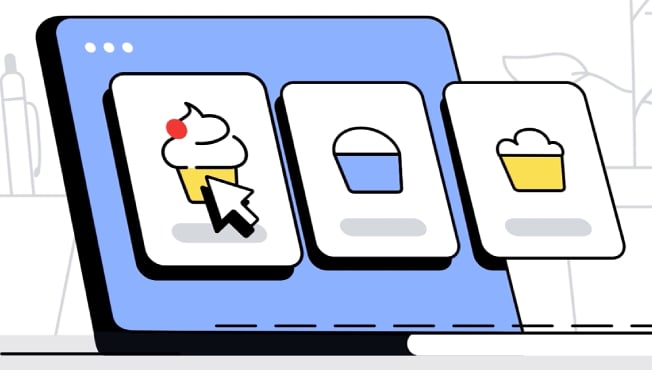When promoting your game on local markets, it makes sense for the game's advertising materials to be translated into the native language of the target audience. Suppose you've already translated the bulk of the content for the game's store page — localized the description, retaken the screenshots. And now you find yourself at the point of localizing the video… Here's where things get a little more complex. Let's take a look at the typical questions that arise when tackling the job of localizing a game video.

Should you re-capture the gameplay?
If the game interface itself has been localized into the target audience's native language, naturally it would be great for the video to reflect this. After all, localization is one of your game's advantages: it can help it stand out from competitors who have not yet invested in localizing into the given language. The obvious solution here is to re-capture the same gameplay scenes as in the original video, but to use the localized version when recording gameplay for the localized video.
This naturally begs the question: why not use the same gameplay recording as in the original version? Couldn't graphics from the localized game version be "patched in" to cover the text elements?
Imagine the following situation. Suppose the upper panel of your game contains several status meters with words like "Level," "Resources," and "Hints." Now suppose your original game video is in English, and you want to localize the video into German. You switch to the German version of the game, take screenshots of the panel, and carefully cover up the English status meters with "patches" taken from the German localization. Seems like a sensible solution, right? And indeed, sometimes this works just fine. But this approach is far from foolproof. Here's why.
-
In different linguistic versions of the game, text blocks can vary in size. If the text blocks expand dynamically depending on the number of words or symbols they contain, their width or height in the localized version can differ from the original. As a result, the recaptured status meter may not cover the entire area of the original, or it may extend beyond its borders, concealing what needs to be visible.
-
If location elements, for example, are visible beneath the text boxes, you'll have to change the UI in the German build to make the status meters opaque, and cover the semitransparent status meters in the English gameplay with "dummy" status meters from the German version. This is particularly important if the background beneath them changes — for example, as a character moves from a cave entrance to a treasure chest, in each scene different location points will end up beneath the status meters. But this still doesn't solve the problem of the mismatched status meter sizes.
-
Text areas can collide with animated effects, both those constantly in view and those that appear at various times in the course of the game.

Let's consider an example of the third instance. The video for the game "One Life Story" contains text elements — wise sayings that accompany each level and provide clues for solving riddles. Note that at levels 48 and 54 the gameplay contains bright dots resembling snowflakes (0:17-0:25 in the video below). The snowflakes pass directly beneath the text. If we were to use the "patching" method, in the localized video these scenes would look rather clumsy. The snowflakes would disappear upon reaching the "patch," and would then reappear beneath it. To avoid this kind of sloppiness, to localize these scenes we recaptured the gameplay from the appropriate linguistic version, then re-edited the captured video from these levels to match timing of the video.

What if the game itself hasn't been localized into the language of the target audience?
You may find yourself in a situation where you are just feeling out the market for a given country, and you decide to start by localizing just the advertising materials (including the video), to assess install dynamics and user LTV, and only then to determine whether it's worth investing in localizing the game for the given language. In this case your game's UI language will not be the native language of your target audience, which means you have two options. The first is for the video to show the UI in the language used in the game. The second is to disable the UI during gameplay for the video.
The first option is the simplest to execute, and you can use the same gameplay as in the original video — at least until the game has a new language version for the given market. Once one is produced, it would make sense to update the video, recapturing the gameplay from the localized version.
The second option is a bit more involved: you'll need to disable the UI in the build, record the gameplay specifically from this build version, then reintegrate the gameplay recording with the localization. This will provide you with fairly universal gameplay, which can be used for any language version of the video.

Videos with no UI: what's the catch?
The downside of the second option is this: text blocks may prove critically important when demonstrating specific features or particularities of the game. Here's an example: one feature of the VR game "Guard of Wonderland" is poetic narrative. It would be hard to showcase this feature in the video without demonstrating the actual text elements.

Of course, this is a rather rare case. More often, various features of the game can be shown figuratively or metaphorically, using animated graphics instead of captured gameplay. This is actually quite a forward-looking solution, as it simplifies subsequent localizations of the video into any language. For example, check out the video for the game "Wild West: Steampunk Alliances." It's a perfect example of how you can make a video without using recorded gameplay at all.

Just don't forget to make sure your animated visuals comply with the rules of the platform where the video will be placed.
If you still decide to use recorded gameplay, you can leave the UI only for the scenes where it is needed. When recording gameplay for scenes where text elements are irrelevant, the UI can simply be disabled. This will help avoid bombarding viewers with information in a language in which they are not fluent.
Combining scenes with the UI enabled and disabled may seem strange in theory, but in practice it should turn out just fine. For example, in the trailer for the game "Pixel Wars," scenes with the UI disabled (at the start of the video) are combined with scenes in which the UI is present. As you see, this approach does not detract from the integrity of the visual sequence.

How to localize voice-overs: three tips
The question of whether to make a trailer with voice-over or without is one you're sure to encounter when making a video for your game. We even wrote a whole article about it. But suppose you decided to do exactly that when creating the original video. This means that when entering a new market you'll need to recreate the voice-over for the video in the native language of your new target audience. Here are three tips to help you do this well.
First tip: don't succumb to the temptation to forgo voice-over in the localization if it is there in the original video. Most likely the offscreen voice in your video is not just decorative, but serves a functional purpose. Through the voice-over you're communicating something important to the viewer, whether a verbal explanation of a game feature or a particular mood that the narrator creates by intonation. Think about it: what will the viewer take away from the video if the voice-over disappears? Will their impression be as complete as that of someone who watches the video with voice-over?
Second tip: only have the translation and voice-over done by a native speaker of the target language (not the source!). Hire a professional translator whose native language is the same as that of your target audience, to avoid glaring semantic errors and stylistic wrinkles. And, of course, have the voice-over text read by a native speaker as well. This will ensure that your video is narrated with the accent and inflections typical of the spoken target language.
Third tip: "copyfit" the text prior to recording — that is, edit the phrases so that they take up approximately the same time in the new language as in the original. If you want to simplify your task of synchronizing the voice-over to the video sequence, pay particular attention to this piece.

How to synchronize voice-over text with the video sequence
Voice-over of a single phrase can take different lengths of time in different languages. Simply put, if your 30-second trailer in English has five scenes accompanied by five phrases lasting five seconds each (25 seconds of sound, plus one-second pauses for scene transitions), it's not at all impossible that in German you'll end up with three 6-second and two 7-second phrases. That's 32 seconds already, even without the pauses; and the 7-second phrases go beyond the 5-second limits of the video scenes. Not a great situation, is it?
The ideal solution to this problem would be to synchronize the video sequence to the voice-over in the new language. The idea is not to fit the recorded voice-over to the animation, but rather to fit the duration of the animation to that of each narration segment. In other words, if the voice-over for a 5-second gameplay scene lasts 6.3 seconds, don't speed up the narrator's speech and don't cut the pauses. Simply make the video sequence two seconds longer — for example, by showing additional seconds of gameplay.
But what if you don't want to re-compile the entire video, forcing the duration of every scene to match the duration of each audio phrase in the new language? Or what if you have to keep to a specific timeframe — for example, to meet the requirements of the platform where you plan to place the video? This is where audio "copyfitting" comes to the rescue, and here's how to do it.
Show the video in the original language to the translator, a native speaker of the target language. Point out the timing of each phrase in the original, then ask the translator to do their best to fit the translation of each phrase to the timing you've specified. Naturally, this limitation may influence the translation's accuracy — certain concepts will have to be rephrased, for example. But the duration of the phrases will now be closer to the original. This in turn will make it easier for you to match the new voice-over to the existing video sequence.

Although you have the option of telling the narrator how long you want the audio to be, you may be shooting yourself in the foot by doing so. Instead of narrating the text at a natural pace, placing the accents logically and pausing where appropriate, the narrator will end up trying to keep within the timing. As a result, the voice-over track may end up sounding less natural and authentic — not exactly what your video needs. The best thing to do is to adjust the volume of text at the translation stage, and allow the narrator to read at a natural pace.
Of course, the duration of certain scenes in the video sequence may still need to be tweaked a little even after "copyfitting." But this is still easier than syncing it to a translation that was created with no consideration of timing whatsoever.
Incidentally, you can even build in a safety net to guard against this when creating the original video. Try to keep the narration from being overly wordy or too packed, so as to keep the reading to a moderate pace. Also, allow for pauses of sufficient duration between the scenes — at least one second, though longer is also permissible. This will be your reserve in the event that the localized voice-over turns out slightly longer than the original.
For example, note how successfully this technique was used to localize the video for "100 Doors XL."

Here the narration is of different durations in the English and Russian versions of the trailer. In particular, the voice-over of the first scene in the Russian version is 0.9 seconds longer than in the English. But thanks to the leisurely pace of the voice-over and the pauses between phrases in the English version of the video, the video sequence did not have to be lengthened for the localization.

Is video localization always so… complicated?
As we mentioned in our previous article for the Academy section, "localizing a video" and "making a video understandable for viewers from another country" are not the same thing. Full localization is a demonstration of the gameplay in the target language, translation of all texts in the frame, and, naturally, redoing the voice-over for the video with a native-speaking narrator. Localizing a video literally means recreating it in a new language, in the course of which you go through all the same stages of production as when creating the original version of the video.

However, the task of "making a video understandable to a foreign audience" can also be accomplished by simpler means. For example, you can simply replace the text captions and re-record the voice-over. Or even — the most economical option — just make do with subtitles. The drawback of these options is that viewers will see right away that the video was not created in their native language. And viewers may even fail to catch some of the concepts conveyed in your video altogether.
Will this affect whether the viewer decides to install the game? It's hard to say for sure. But you can try this experiment: show the same segment of your target audience a "fully localized" video, then a "somewhat understandable" version, and see which version of the trailer brings you the most users. And if you've already done so, would you mind sharing your findings in the comments?
How much does video localization cost?
If you localize the video yourself, it's more a matter of man-hours. Perhaps the simplest and fastest video to localize is one with animated graphics, with little or no text in the frame. On the other hand, this type of video is considerably harder to create than one comprised of gameplay. In other words, you'll spend more time and energy creating the original video, but you'll save on localization into any language.
Localization becomes more complicated when the gameplay has to be recaptured from the required language version of the game, after which the newly recorded fragments have to be edited and synced to the new voice-over track. Here the workload is comparable to that of creating the original video — all that's missing are the "scripting" and "background music selection" stages.

If you order outsourced video localization, be sure to provide the outsourced team not only with your original video project, but also with pre-edited versions of the gameplay recordings. If you've decided to re-capture gameplay from the localized version on your own, don't forget to add the re-captured gameplay files to the source, specifying the timecodes of the fragments you want to see in the video.
Of course, the cost of localization varies considerably depending on the project. If we were to offer a "guesstimate" of the average cost, localizing a game video can run between 20% and 70% of the cost of the original video. At the lower end are videos that only need to have new voice-over recorded, store badges replaced, and taglines translated — all with no changes to the timing of the video sequence. At the upper end are videos that have to be completely recompiled, including replacing gameplay fragments and resyncing the video sequence, music, and sound effects to the voice-over in the new language.
Checklist: 8 things to remember when localizing a video
-
Is the name of the game localized? If so, don't forget to use the game's localized name in the video instead of the universal version. It may come up both in the voice-over and in the video sequence. If the game's name is used in the logo, don't forget to replace the logo in the localized video.
-
Is the game itself localized? If so, consider using gameplay in the target language for the video.
-
Does your gameplay include embedded texts? For example, a location may have inscriptions on shop signs or road signs. If these elements are present, think about how to treat them in the localized video. Remember that the "patching" method, while attractively simple in theory, frequently proves quite the opposite in practice.
-
Does your video contain text captions or taglines? If so, don't forget to translate these texts and select a typeface for them that is compatible with the target language.
-
Does your video contain app store badges? If your game is for a mobile OS, the answer is yes. Don't forget to replace the original badges with translated versions. You don't need to translate them yourself: official versions of badges in various languages can be found in the App Store and Google Play guidelines.
-
Does the original video contain voice-over? If so, don't forget to translate it and have the translated voice-over read by a native speaker of the target language.
-
Is your timing strictly limited? For example, the advertising platform may limit the teaser to 15 seconds, or the App Store may have a limit of 30 seconds for trailers. If there are timing restrictions, keep these in mind when translating the voice-over text.
-
Will you have to change the duration of scenes or re-capture gameplay for the localized version of the video? If so, don't forget that you may have to reformat the background music and resync the sound effects corresponding to key events in the animation. Because if the actions in the video sequence shift on the timeline, the accompanying "SWISH!" "BAM!" or "SMACK!" will also need to be shifted accordingly.
If while reading you've been applying the examples and situations outlined in the points above to your own game, you've doubtless picked up on details that would never have occurred to you before. If so, congratulations! You've spent the last ten minutes well. Now when you localize your video you'll have fewer surprises. You'll also be able to calculate expenses and deadlines more realistically. Here's to your success as you bring your game to new markets!


















